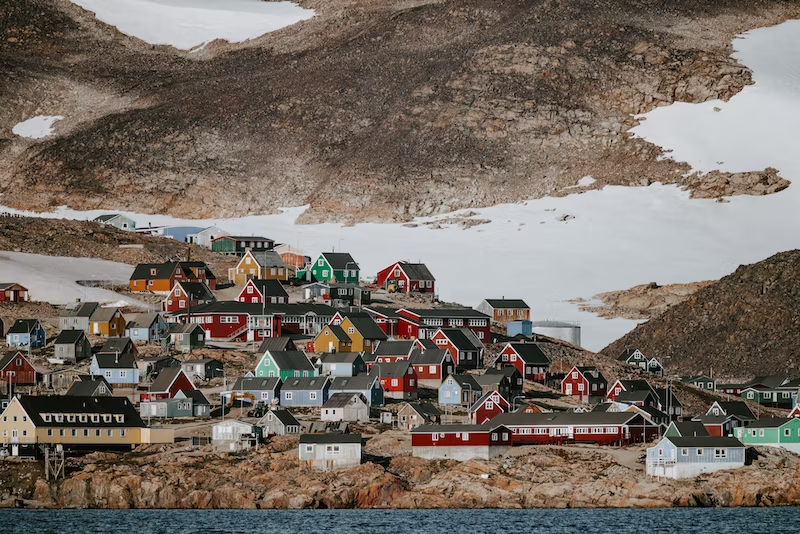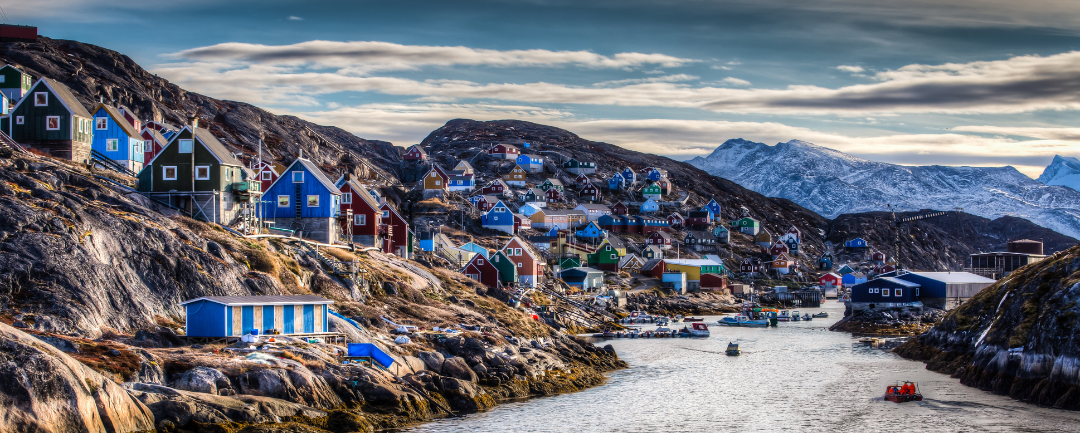Top Banks in Greenland
Greenland is often confused with Iceland, as both are between the Atlantic and the Arctic Ocean.
Greenland is often confused with Iceland, as both are between the Atlantic and the Arctic Oceans.

Technically speaking, Greenland is a part of North America, whereas Iceland is a part of Europe. But, believe it or not, there are only two banks on the entire island of Greenland.
The only two banks in Greenland are:
- The Bank of Greenland and
- BankNordik.
While there are only two banks on the world's largest island, Denmark is Greenland's sole supervisor and financial regulator.
This makes sense because Greenland is known for its "icy conditions"; contrary to popular belief, Greenland is much colder than Iceland.
Additionally, Greenland is one of the northernmost countries in the world, which means that it is covered by 80% of permanent ice – all uninhabitable and not convenient for transportation.
To summarize, because of Greenland's climate and geographical location (the northernmost country of the continent of North America), Greenland only is home to 2 banks (both commercial and not investment).
On the contrary, as of 2021, there were 4,236 FDIC-insured commercial banks in the U.S. Additionally, the U.S. is known for its intensive investment banking industry, which is often referred to as Wall Street.
NOTE
Little economic activity (let alone Wall Street) is taking place in Greenland.
Financial Institutions
Before we discuss the significant banks in Greenland, it’s worth mentioning that there are more than the everyday consumer-facing “retail/consumer” banks that you’re undoubtedly already familiar with.

While there is no universal definition per se for a financial institution, we tend to think of financial institutions as companies that engage with clients in financial transactions, exchanges, loans, deposits, investments, and everything else under the sun related to money.
It’s also worth noting that while there are different “types” of financial institutions, some firms (a firm is a “for-profit” company, the opposite of a “non-profit”) contain two or more services.
EXAMPLE
For example, JPMorgan Chase is a commercial/retail bank and an investment bank.
For your understanding, you can think of an investment bank as a firm that services corporations and occasionally governments – not typical everyday people like me and you.
The three most common types of services that investment banks offer are as follows: Mergers & Acquisitions (M&A), Restructuring (Rx), and Capital Raising (via Equity - IPO and Debt - bonds).
- M&A is where the investment bank helps a company buy another company or sell itself to a larger entity
- Restructuring (Rx) is where the investment bank will advise either the organization that loans the money (the creditor) or the recipient of the debt (the debtor) in times of financial distress.
- Capital Raising (via Equity - IPO and Debt - bonds) is basically where a company will come to the investment in hopes of raising money to fund business operations.
Top Financial Institutions in Greenland
As you go through the rest of the article, you’ll find a list of the most common financial institutions.

Although Greenland only has retail banks on the island, below are the most common financial institutions:
1. Retail / Commercial Banks are the types of banks that you’re likely already familiar with. Retail / commercial banks typically cater to everyday citizens like you and me for services such as loans (think mortgages for a house) and deposits.
2. Brokerages are companies that buy and sell securities (basically the “middleman”). Types of securities include stocks, bonds, derivatives, ETFs, etc.
3. Investment Companies are the “catch-all” category. Essentially, investment companies typically pool a group of investors’ money and invest that amount in asset classes based on the client’s risk tolerance.
NOTE
The most common types of investment companies you’ve likely heard about are mutual funds, hedge funds, private equity (buyout shops), and venture capital firms.
4. Insurance companies collect PREMIUMS from customers who want to be protected in case of an unforeseen future event (accident, disability, death, etc.). Additionally, they pay out CLAIMS to customers if / when an accident occurs.
NOTE
Most types of insurance policies include life, auto, home, disability, and health.
5. The Central Bank (a.k.a. “The FED” in the U.S.) is the following type of financial institution that we’ll discuss. Undoubtedly, the central bank is the most important financial institution in any country’s economy.
The primary job of the central bank is to oversee all economic activity and keep the state of the country’s economy in check (e.g., inflation).
NOTE
The most powerful central banks in the world include the Federal Reserve (FED), European Central Bank (ECB), and Bank of England (BoE).
6. Internet banks are similar to regular commercial banks, except they provide their services entirely online. As a result, in-person interactions are not common for internet banks.
7. Credit Unions operate similarly to commercial/retail banks, but these institutions are owned and managed by members of a specific demographic and section of society. Simply put, the pooled money is used to benefit the union members in any financial circumstance.
8. Savings and Loan Associations specialize in deposits (savings) and mortgages (loans). Today, most people combine commercial/retail banks with savings and loan associations.
NOTE
Most mortgage companies offer many consumer services, and some other companies only service real estate transactions.
9. Advisory Firms assist individuals and businesses in assessing risk and making the best financial decisions. The most common type of advisory firm is consulting firm (think McKinsey, Boston Consulting Group, and Bain).
10. Trust Companies make money by charging fees depending on the size of the assets being transferred from benefactor to beneficiary. These types of companies engage in what’s referred to as “wealth management.” You can think of wealth management as the preservation of money.
The Top Banks in Greenland
Of the 12 types of financial institutions (see discussion above), Greenland only contains 1 of the 12 financial institutions, which are respectively retail/commercial banks.

Trying to justify why Greenland is unimportant in the financial sector is quite simple – its overall climate makes it impractical for commercial activity and life in general.
With a mere population of 57,000+ (U.S. population: 333 million+), having lots of businesses migrate to the island is simply impractical. Many industries that we know and love in the U.S. cease to exist here in Greenland and instead are replaced by more “primitive” business industries.
NOTE
Compared to industries in the U.S., Greenland simply does not have the vast amount of industries in the U.S.
Greenland’s main industries include fishing, mining, and forestry. A small sector like this does not need that many banks on the island.
Complex industries simply cease to exist to the extent that the U.S. companies such as:
- Technology, media, and telecommunications (TMT)
- Industrials
- Consumer and retail
- Various financial institutions
- Energy (fossil fuels and renewables)
- Healthcare
There are only two main players in Greenland; commercial banks are the most common type of bank (no investment bank).
Bank of Greenland
The Bank of Greenland, established in May of 1967, is the local central bank of the island and has its headquarters in Nuuk.

Its primary purpose is to provide commercial services, which means that it is heavily geared toward consumers (you and I).
More specifically, this central bank provides additional services such as specialized financial products (loans, technical and automated deposits, administration work, and property trading).
As the only commercial bank of the Greenlandic people, they recognize that there is a critical urge to help out smaller companies.
Due to this notion of limited entrepreneurs, the Bank of Greenland set aside a small pool of money to assist startup companies. It’s important to note that Greenland is the least densely populated region in the world.
Additionally, the Danish government retains control of the defense, citizenship, and economic affairs.
The above two points are important to note as they both remind us why the Bank of Greenland is 1 of the two banks on the island. There are over 50,000+ customers that use one of the Bank of Greenland’s branches in each of the major towns.
NOTE
The headquarters of the BoG is located in the center of Nuuk, Greenland. Therefore, it makes sense to have the commercial bank’s office here, as Nuuk is the capital of Greenland.
The one and only competitor of the BoG is BankNordik. Greenland’s main source of income is via the fishing industry (shrimp and fish), so the BoG deals a lot with fishermen as the country’s biggest bank.
Furthermore, individuals can invest in the BoG if they choose to by purchasing shares on the Copenhagen Stock Exchange (CPH: GRLA).
BankNordik
BankNordik is one of the two full-service banks in Greenland and has most of its branches in Denmark.

Some notable mergers & acquisitions (M&A) of BankNordik include acquiring 12 branches of Sparbank (February 2010), and in 2011, the bank acquired a portion of Amagerbanken’s assets.
BankNordik provides commercial/retail banking and some insurance services as a Faroe Islands-based financial services company. It’s worth noting that BankNordik’s market share of the Faroe Islands is around 40%.
To clarify, the Faroe Islands are a self-governing nation under the external sovereignty of Denmark – the people are Danish. The North Atlantic archipelago is found halfway between Norway and Iceland.
BankNordik has three executives in its senior management; they are as follows: Árni Ellefsen (CEO) and 2 Executive Presidents (Turið F. Arge and Heini Thomsen).
NOTE
You can invest in BankNordik on the Copenhagen Stock Exchange (CPH: BNORDIK-CSE).
If you are from the U.S., you can invest in foreign securities via American Depository Receipts (ADRs), Global Depository Receipts (GDRs), Foreign Direct Investing (global account with the online broker), or through Global Mutual / Exchange-Traded Funds (ETFs).
Although you might be susceptible to volatility and accounting fraud, it is very much possible to invest in financial institutions such as the BoG or BankNordik. Additionally, as of 2021, BankNordik’s assets under management (AUM) are 2.2bn+ DKK.
Key Takeaways
- Greenland has only two banks on its island.
- There are no investment banks or other financial institutions other than commercial/retail banks.
- Small entrepreneurs are encouraged to expand because a pool of funds is waiting for them from BoG.
- Business / economic activity on the island is limited because of other first-world countries' poor climates and geographical locations.
- The two central banks of the island are BankNordik and the Bank of Greenland.
- The main currency of the island is the Danish Krone (DKK).




or Want to Sign up with your social account?